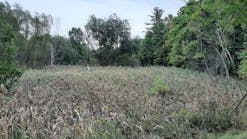Silt Fence and Wattles Stay the Course
Classic performers in any field remain popular because they serve a purpose and they execute it well. Take, for example, sediment control. While many materials used for this objective on project sites around the globe have become more environmentally sensitive and more effective regarding their intended purpose in recent years, it is the products’ function onsite and their ability to meet increasing environmental standards that ultimately determines their use. The reasons silt fencing and wattles remain viable with the industry, however, are clear: affordability and versatility.
Whether the site is rural or commercial, residential or industrial, the following examples explore a variety of products and their functions in overcoming challenges that support the use of silt fencing and wattle protection, used independently or in combination with other erosion control measures, in providing lasting, reasonably priced sediment control.
Steep Housing
With a growing need for more student housing, McComas-Lacina Construction, based in Iowa City, was contracted to build new dorm space for students at the University of Iowa in Iowa City in June 2012.
Existing buildings and structures surrounded the site where sediment loss was a concern because of its approximately 3:1 slope. McComas-Lacina workers used more than 990 linear feet of Grimes, IA-based Soil Tek’s e-tube wattles. The product’s flexibility allowed it to protect the soil as it wrapped around structures at the 1.5-acre site where a 14-story dorm will be located. The biodegradable e-tube is filled with a blend of compost and mulch. Water filters through it, while sediment is trapped before it’s lost. The product’s durability was tested during a recent rainstorm that produced three-quarters of an inch of rain per hour, with zero site loss, notes Mike Youngman, Soil-Tek’s project manager for eastern Iowa.
Mobility also was a concern at the site, where there are many different contractors located within a single confined space. The e-tubes can be moved and then “put back in place before they leave the site and before another rainfall,” says Youngman. The e-tubes will remain onsite throughout the project. Even with the necessity of mobility onsite, most of the e-tubes are expected to last through the duration of the project, with an anticipated completion in 2015.
“We expect to put an additional 200 linear feet out there over the next two years,” adds Youngman.
Seeding and matting were also included in the approximately $55,000 to $60,000 erosion control budget.
Pipeline projects are another type of environmentally sensitive undertaking for many reasons. Using natural solutions is crucial, as is protecting sediment loss in wooded, mountainous regions.
Mountain Pipeline
In May 2012, Sheehan Pipe Line Construction Co. was contracted to work on a pipeline project in Mountainsville, WV, for Chesapeake Energy. The company built the right of way for a mainline gathering system deep in the Appalachian Mountains.
Larry McVay of Tulsa-based Sheehan says the terrain was very rugged. “Seventy-five percent of the project has steep slopes. It was virgin timber.
“This wasn’t an existing right of way,” he adds. “We had to remove all the trees and start from scratch, more or less.” Most of the trees are maple and hardwoods.
Workers used Conyers, GA-based Silt-Saver BSRF Priority 1 Silt Fence and Priority 2 Silt Fence. Both are 36 inches wide and both are made of nonwoven, spun-bond, polyester fabric attached to wooden stakes. “The gas company, a lot of times, will put it in their specs that we use Silt-Saver,” explains McVay, who adds that this silt fencing was selected for the Mountainsville site because of its quality, low maintenance, and the company’s service.
Red clay, he says, makes up 90% of the soil at the site. “We use small trenchers to cut a small ditch, and then we install the silt fence and boost the dirt against the silt fence,” he says, adding the approximately 20,000 feet of fencing was largely used around the perimeter of the site, though it was also positioned on some steeper-sloped areas.
The fencing was used in combination with a compost-filled wattle from Filtrexx International LLC. “We use the FilterSoxx anytime there’s a drainage with a heavy rain at the bottom of any hill or mountain,” notes McVay.
Daily monitoring is ongoing at the site. This phase of the ongoing project is expected to be completed this fall. Timing was essential for the erosion control and revegetation aspects of this project as workers aimed to establish a strong root base for plants at the site before winter. Pasture and woodland mixes of grass seed were applied. While there was no written requirement that native seed was to be used, explains McVay, “that’s what we normally do to whatever is native to the areas.”
Replacing a Water Main
Another site that combines a variety of techniques, including silt fencing and wattles, is an ongoing water main instillation project at Fort Belvoir military base in Virginia.
Work at the 80,000-acre site began in 2010, stopped briefly, and resumed in August 2011. Sediment control at the site where 144,000 feet of water main is being replaced had been a challenge. George Galachiuk, superintendent at the site for Indianapolis-based Bowen Engineering, says the company tried several erosion control methods before selecting Gator Guard Environmental Products’ Gator Guard reusable sediment control wattle to be used in coordination with silt fence and straw. He says that while several previous methods of sediment control disintegrated when vehicles on the busy base rolled over them, this was not the case with the Gator Guard.
“We’re able to reuse them,” says Galachiuk. “The Gator Guards are extremely tough and hold up really well. We use them on the downside of all of dirt and soil piles. This way any rain that gets on top of the pile goes into the Gator Guard and not into any of the other areas we’re working in.”
The area is rife with construction-hotels, child development centers, hospitals-and the sediment control methods chosen have to respond to heavy traffic while the water main is being replaced in phases.
“The [base] size is the challenge. We’re not doing the whole thing all at once, but we’re all over the place,” says Galachiuk, noting that the replacement is anticipated to be completed in 2013. “We have areas on the north side of the base, south side of the base-we’re getting the worst pipes first. There are some areas that are higher up and significantly lower areas. We’ve used 4,000 linear feet of Gator Guard on site because it works so well.
“We use straw bales to protect the catch basins and fabric for the catch basins,” he adds.
With a UV-resistant geotextile as its outside wrap and filled with recycled foam, the Gator Guard has an anticipated life span of five years. The units are cut to fit and connect end to end. Each has an apron that should be pinned approximately every 3 feet with an inch of dirt covering the apron, according to the company.
In addition to the Gator Guard, a variety of silt fence and super silt fence was placed in large areas such as swamp areas and wetlands.
“You have to disturb more ground than with the Gator Guard,” says Galachiuk, referring to the instillation of silt fence. “We will be using seed and straw for revegetation. We’re using contractor [grass] mix while the plants are removed, watered, and replanted.”
The project is about 40% completed, and the work that is remaining is being completed more quickly. “We’re in areas where there’s less disturbance, where it’s more open.,” says Galachiuk. “We’re able to get pipe in quicker now.”
Workers monitor the site each week as well as after significant rains, such as one that took place on June 29.
“The wind made significant damage; it took down trees, roofs. People were without power for five days,” says Galachiuk, noting that the Gator Guards remained staked down. “Between the stakes and the dirt, they worked really well. They held up fine.”
Installation Techniques
Proper installation is vital in creating a stable silt fence barrier in any setting. Terry Venteicher, owner of 3D Erosion Control in Des Moines, IA, has installed more than 4 million feet of silt fencing during his lifetime. He currently uses Ankeny, IA-based Devon Distributing’s tommy Silt Fence Machine on sites that range from residential to rural.
“The tommy has a narrower knife. I can get it in faster,” he explains. “It makes a J that runs along the wheel. You get about 18 inches in the ground and about 18 inches out of the ground.”
“The vertical wheel, positioned between two narrow parallel panels, is a moving pivot where the horizontal silt fence fabric is converted to a vertical position between the panels,” according to the manufacturer. The fabric is “simultaneously pulled off the roll by the vertical wheel, funneled into the apparatus, converted to a vertical position between the panels, and inserted into the soil” that has been opened by the panels. The soil will then collapse on the fabric, securing it.
Other machines Venteicher says he has used required more horsepower in the form of a larger tractor than he uses to pull the installer.
A 30-horsepower utility or larger tractor, or a 60-horsepower or larger skid-loader, is needed to pull the tommy through the soil. It uses what’s known as a static-slicing method.
“I have more maneuverability with a smaller tractor that can pull the tommy,” says Venteicher. Bouncing from site to site, he says, he can install as much as 2,150 feet of silt fence in a single day by himself. One particularly challenging site is Windmill Farm in Mecina, IA, which produces corn and soybeans on 300 acres; installation sites at the farm can be very spread out. “They have windmills, but the site where the windmill is might only be a half an acre.”
Venteicher often combines silt fencing with another sediment control method. He takes wood chips and places them in a heavy fabric. This “works in the same way a filter sock” would, he says.
The tommy works well on housing development sites as well, where the project “requires all four sides of [the site] to be protected. In a smaller tractor, you can keep that tighter to the lot line as you need,” says Venteicher. “If you have a bigger tractor, you are about 4 feet off the boundary.”
Streambank Stabilization
On another project also located in a residential area, the Filtrexx Bank Stabilization system was used on a streambank restoration project that took place last April in Charlotte, NC.
“The backyard of a residential property near downtown Charlotte was being washed away during rain events due to recent construction upstream that was increasing the amount of water that was being distributed into the stream,” explains J.R. Stewart, a Filtrexx representative who helped oversee the installation by Eco-FX Environmental, a certified Filtrexx instillation team. “The client wanted to go with a green approach to stabilizing and reclaiming her fence and yard. Also, the extremely limited accessibility hindered the use of heavy equipment for any type of concrete product to be utilized.”
The client’s house is located on a lot that backed against the stream. Houses nearby were built close together and that, in combination with a narrow driveway and excessive grades into the backyard, made the area inaccessible for heavy equipment, says Stewart. “The Filtrexx Bank Stabilization product allowed for the bank to remain stable while germination was achieved,” he says. “The mesh material filled with compost and seed mix helps to stabilize the bank prior to germination. Germination is the long-term fix.”
The weather provided another challenge. “During rain events, the water level rises extremely high on this channel, so the work needed to be performed in a very timely manner to avoid a rain event washing away or damaging an unfinished project,” he notes. Using vegetation that grows within the tubular mesh nettings, the Filtrexx Bank Stabilization system creates a natural anchor to stabilize waterway banks and prevent future erosion of riparian areas. The soft-armor system sometimes includes geogrid for structural stability.
In addition to the system, Eco-FX Environmental used SiltSoxx above the bank to control sediment during construction at the site. The palletized SiltSoxx were delivered and installed there before construction began. SiltSoxx provide filtration as water flows through the compost-filled tubes that are designed to trap sediment. When a project site surface is sloped and SiltSoxx are used, the tubes also naturally slow down water velocities. Each month, Eco-FX Environmental visits and monitors the site.
Repurposing a Plant
Sediment control in urban areas brings its own unique challenges. In Newark, DE, the site of a former Chrysler plant is evolving. A local university is planning to find a new use for the site; now that the plant itself has been torn down, the school contracted Lindstrom Excavation to begin installing a gas main in mid-June 2012. Runoff at the site, which has approximately 60 acres of blacktop, had been an initial concern in terms of sediment control during construction.
“The original design for the project included silt fence,” says Duane Lindstrom, president of Lindstrom Excavating Contractors Inc., based in Worton, MD. He suggested using Erosion Eels, from Friendly Environment in Shelbyville, TN, which he felt were more suited to this particular site. “Since you have a hard surface, it’s beneficial to use the Erosion Eel so you don’t have to disturb anything. At the end, it’s less expensive compared to putting silt fence in and pulling silt fence out.”
The erosion control budget for the project is approximately $50,000 and includes the Erosion Eels, which are distributed on the East Coast by Richmond, VA-based ACF Environmental. Lindstrom had used them on a project in the past where workers were dredging a harbor, and he found the product useful for protection at that location. At the former industrial site, Lindstrom says, the Eels would not destroy the existing blacktop. “Some of the pavement goes back, some gets filled in with stone,” he says. “No one knows what is going to be built there in the future.
The gas line is approximately 4,000 feet, and the Erosion Eels were placed around the area of disturbance. The ease of moving the Eels was also appealing.
“When you have done a certain area, you can move the Erosion Eels very easily,” notes Lindstrom, who said the site does have slopes affecting runoff in a rain event. “We’re able to line the catch basins as a secondary defense against erosion.”
Following a powerful storm that caused extensive damage and took out power along the east coast on July 29, the product held up very well, he says.
The Erosion Eels served as the primary sediment control method and were approved for use at the site by the state. The product is filled with shredded rubber from used tires. When a project is completed, this filler is then reused in new Erosion Eels after it has been cleaned. The geotextile wrap is recycled for use in automobile plastics, according Friendly Environment.
In this field, sediment and erosion control requirements have become stricter, says Lindstrom, and are actively being enforced. The Erosion Eels have helped the project meet requirements. State representatives come to inspect the site weekly, he says.






